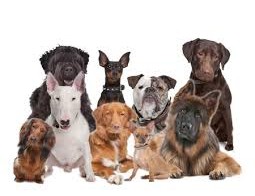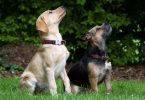The average pet owner has no idea how strong the gene is that controls their puppies drives, temperament and personality. Puppies that don’t have a solid pack structure grow up to be dominant, obnoxious adults.
When people first bring their new puppy home they are concerned with what to feed the puppy and how to stop it from peeing on the floor. These are credible concerns, however equally important is the concept of how to establish yourself as your puppies new pack leader.
Dogs like wolves are predators. Dogs like wolves, live in packs. A pack consists of a leader and lower ranking pack members. Dog packs are not a democracy. They are a well organized hierarchy according to rank. Simply put this means that every pack member knows exactly what his rank is within the family pack. All pack animals genetically understand this concept. This concept cannot be changed by humans. This concept is the reason people have dog fights when they bring a new dog into a home that already has dogs. Everyone has to reestablish pecking order when a new member comes on board.

Pack structure begins when a puppy is raised with litter mates. They begin to establish pack structure at about 4 weeks of age. They do this by biting and pushing each other around. The puppy that bites and pushes the hardest is the highest ranking member. There is no question that the mother is the pack leader. She exerts her leadership by driving the puppies away from her food dish until she is finished eating and she protects the pack.
When people bring their new puppy home they need to establish themselves as the puppies new pack leader. To do this correctly, you need to understand exactly what a pack leader is. Pack leaders are aloof, calm and self confident. You are a fair dictator who enforces a well defined set of rules that pack members know, understand and live by. A pack leader never looses his temper or bullies the pack members into compliance. It is easy to bully your way into a leadership position. People, mostly men, do this all the time. The problem is bullying destroys the bond and relationship with your dog.
You want your pack members to trust you. You want them to feel relaxed and confident in your presence. The only way this can happen is if they know the rules and anticipate our expectations. When that happens, they know they will be treated fairly. They also know if they break the rules, they suffer the consequences.
The leadership relationship is a learned endeavor. It is learned through day to day experiences of living with a owner who establishes and enforces rules. There are hundreds of dogs that go through obedience training every year who are no better behaved than when they started. That’s because the owners were not taught pack structure.
Tips on Establishing Pack Leadership
Control All Food-Establish specific feeding schedules. You decide when dinnertime is, where he eats and how much he gets. Before placing your food bowl down, make your dog perform a simple obedience command. I make my dogs sit and wait until I tell them it’s okay to eat. If your dog dives into his food bowl before you give him permission, simply pick it up and start over or don’t give him his food until the next scheduled feeding. Do not leave food down all day and allow your dog to graze. Place the food bowl down for 15 minutes. If he doesn’t eat, he doesn’t get his meal until the next feeding. This will teach your dog to eat on command and will also establish you as leader, in the same way the mother dog drives the pups away from her food bowl .
Sleeping Arrangements-Leaders get the best spot in the bed or on the couch, not subordinates. Sleeping in their own bed away from you or in a crate spells out clearly for your dog that you are leader. If you do allow your dog to sleep in the bed or on the furniture, be sure that they wait until invited and that they do not protest when you tell them to move. Bossy or dominant dogs should not have this privlege, it needs to be earned.
Toys-Dogs that push toys in your face and demand to play think that they set the rules. Leaders say what toys to play with, when to play and for how long. Your dog should give you the toy on your command with no complaint. Dogs should be taught that all toys are your toys and he is allowed to play with them. I normally do not leave toys laying around my house. When we are finished playing, I pick the toys up and put them away, especially when they are in training. The only time I allow toys is in their crate if I am leaving them alone for a period of time.
Right of Access-Leaders always go first. You establish yourself as leader by going through doorways, up and down stairs, and in and out of hallways ahead of your dog. I teach my dogs to automatically sit at all doorways and wait until I tell them they can move. Leaders decide who comes and goes and who is accepted and who isn’t. When guests come to my home I place my dog in a sit or place command to discourage them from jumping up on and bothering visitors. If my dog is laying in my way when I walk through the house I make him get up and get out of my way, I do not walk around him when he is in training.
Respecting Space-Do not allow your dog to jump up on and climb all over you. Do not allow him to jump up on counters surfing for food. Do not allow your dog to beg for food and swipe stuff off kitchen counters and tables. This is disrespectful. Show him that you are in charge and in control of the situation.
Demanding Attention-Ration everything your dog loves, toys, food, attention. Everything he loves and wants needs to come from you and on your time frame. If your dog comes to you nudging you for attention, to play or be petted, make him earn your attention and affection by making him do a simple command first such as sit or lie down, then offer him some loving or play.
Be Consistent-Dogs learn by repetition and consistency. Always enforce the rules and teach all family members and visitors to do the same. By doing so, you will have a pet that is a pleasure, not a pain, to be around.
Ed Frawley






